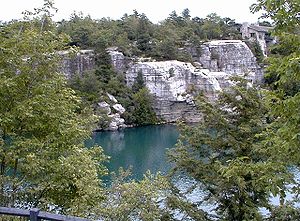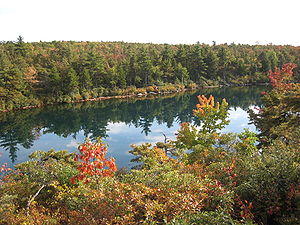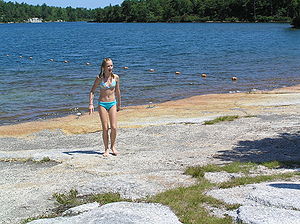
Minnewaska State Park Preserve
Encyclopedia



Shawangunk Ridge
The Shawangunk Ridge , also known as the Shawangunk Mountains or The Gunks, is a ridge of bedrock in Ulster County, Sullivan County and Orange County in the state of New York, extending from the northernmost point of New Jersey to the Catskill Mountains.The ridgetop, which widens considerably at...
in New York
New York
New York is a state in the Northeastern region of the United States. It is the nation's third most populous state. New York is bordered by New Jersey and Pennsylvania to the south, and by Connecticut, Massachusetts and Vermont to the east...
on US 44
U.S. Route 44
U.S. Route 44 is an east–west United States highway that runs for 237 miles through four states in the Northeastern region of the United States. The western terminus is at U.S. Route 209 and New York State Route 55 in Kerhonkson, a hamlet in the Hudson Valley region of New York...
/NY 55
New York State Route 55
New York State Route 55 is a state highway in southern New York, running from the Pennsylvania state line at the Delaware River in Barryville to the Connecticut state line at Wingdale...
, five miles (8 km) east of New York State Route 299. The park is managed by the Palisades Interstate Park Commission
Palisades Interstate Park Commission
Palisades Interstate Park and its creator, the Palisades Interstate Park Commission, was formed in 1900 by governors Theodore Roosevelt of New York and Foster M. Voorhees of New Jersey in response to the destruction of the Palisades by quarry operators in the late 19th century...
. It is primarily used for picnicking, hiking
Hiking
Hiking is an outdoor activity which consists of walking in natural environments, often in mountainous or other scenic terrain. People often hike on hiking trails. It is such a popular activity that there are numerous hiking organizations worldwide. The health benefits of different types of hiking...
, mountain biking
Mountain biking
Mountain biking is a sport which consists of riding bicycles off-road, often over rough terrain, using specially adapted mountain bikes. Mountain bikes share similarities with other bikes, but incorporate features designed to enhance durability and performance in rough terrain.Mountain biking can...
, snowshoeing and swimming. There are outstanding views of the nearby Catskill Mountains
Catskill Mountains
The Catskill Mountains, an area in New York State northwest of New York City and southwest of Albany, are a mature dissected plateau, an uplifted region that was subsequently eroded into sharp relief. They are an eastward continuation, and the highest representation, of the Allegheny Plateau...
. There are three sky lakes within the Park Preserve: Lake Minnewaska, Lake Awosting, and Mud Pond. Lake Minnewaska is roughly a mile long by a quarter-mile at its widest point. Lake Awosting is roughly twice as large.
History
Originally part of Albert and Alfred Smiley's Mohonk Mountain HouseMohonk Mountain House
The Mohonk Mountain House also known as Lake Mohonk Mountain House, is a historic American resort hotel located on the Shawangunk Ridge in Ulster County, New York. Its prominent location in the town of New Paltz is just beyond the southern border of the Catskill Mountains on the western side of the...
property, the Minnewaska Mountain House, or Cliff House, was built in 1879 overlooking Lake Minnewaska; it could accommodate 225 guests. After managing and developing Mohonk's early growth for ten years, twin Alfred H.Smiley purchased and developed Minnewaska separate from Mohonk, but brothers exchanged courtesies to each others' guests. A second hotel, Wildmere, accommodated 350 guests. In 1955, Kenneth B. Phillips, Sr., the Minnewaska general manager bought the property from the Smiley family. Cliff House was abandoned in 1972 due to maintenance costs; it burned to the ground in 1978. Wildmere closed in 1979 and burned to the ground in 1986. After years of wrangling over commercial development proposals and lawsuits to block development, New York State bought the property in 1987 and opened the Minnewaska State Park Preserve in 1993. A significant expansion of 5400 acres (2,185.3 ha) occurred in 1996 when the Open Space Institute transferred acreage to the Park Preserve from the old Ellenville watershed lands, now called Sam's Point Preserve, currently managed by the Nature Conservancy and owned by the Open Space Institute. http://www.nature.org/wherewework/northamerica/states/newyork/preserves/art12207.html Located within the Minnewaska State Park Preserve and neighboring Mohonk Preserve
Mohonk Preserve
The Mohonk Preserve is located in the Shawangunk Ridge, a section of the Appalachian Mountains, north of New York City in Ulster County, New York, USA. The Preserve is west of the Village of New Paltz...
is the Trapps Mountain Hamlet Historic District
Trapps Mountain Hamlet Historic District
The Trapps Mountain Hamlet Historic District is located on the Shawangunk Ridge in Gardiner, New York, United States. It is a large area that covers the site of a settlement that thrived there from the late 18th to mid-20th centuries. Inhabitants practiced subsistence farming, making it one of the...
, listed on the National Register of Historic Places
National Register of Historic Places
The National Register of Historic Places is the United States government's official list of districts, sites, buildings, structures, and objects deemed worthy of preservation...
in 2000.
Recent expansion
In March 2006, an additional 2,500 acres (10 km2) were added to the Preserve as a result of action by a coalition of conservation groups. Their success was made possible in part because the real estate partnership that sought to develop the property collapsed due to an internal financial dispute. To settle this dispute among the partners, a court ordered that the property be sold. http://www.shawangunkridge.org/articles/nthr031506.htmEcological characteristics
Unique communities such as Ice Cave Talus http://www.acris.nynhp.org/guide.php?id=9964, Pitch Pine-Oak-Heath Rocky Summithttp://www.acris.nynhp.org/guide.php?id=9968, and extensive Chestnut Oak Forest http://www.acris.nynhp.org/guide.php?id=9982 comprise Minnewaska State Park Preserve. These ecosystems host a variety of plants and animals that are uncommon in New York State. Wildlife such as the Timber Rattlesnake (Crotalus horridus), Bobcat (Lynx rufus) and New York State's only documented occurrence of the noctuid moth Zale curema reside within Minnewaska State Park Preserve. http://www.acris.nynhp.org/guide.php?id=7999&part=3Swimming in Lake Minnewaska

On April 19, 2000 Judy Mage, Myriam Miedzian, and Ellen James met with Park officials and the PIPC (Palisades Interstate Park Commission) to present proposals for the allowance of distance swimming on the lake. As a result of this meeting the designated swim area in the lake was increased and the closing time for swimming was extended by half an hour.
On June 11, 2000 SWIM (Swim Without Interference at Minnewaska) was created to attempt to bring back swimming throughout the entire lake. After much debate and negotiations with Parks officials, SWIM proposed the formation of a club where members would be tested for swimming ability, purchase insurance cards, and sign release of liability forms. The group was able to secure a second swimming area consisting of a 200-yard buoyed cable that runs parallel to the shoreline for distance swimming.
In the Spring of 2002 SWIM became the Minnewaska Distance Swimmer's Association (MDSA) and signed up 430 members its first year. Currently the MDSA has close to 700 members. http://www.minnewaskaswimmers.org/history.htm

